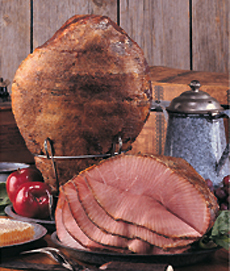
MELODY LAN is a member of THE NIBBLE editorial staff.
|
April 2006
Updated March 2009
|
 |
Best Hams: For The Holiday Or Any Day
Page 3: Types Of Ham
This is Page 3 of a six-page review. Here, we demystify the different cuts and types of ham. What’s a butt ham? A city ham? A country ham? A fresh ham? A wet cure? A dry cure? See the answers below. Click on the black links below to visit other pages.
Ham Cuts
Hams come from the pig’s two back legs.
| Cut |
Description |
| Butt Ham |
Meat taken from the top half of the leg. It has more fat and meat than shank ham and is easier to carve around the bone. |
| Center-Cut Ham Steak |
Slices cut from the center of the leg that vary between 1/2- to 1-inch thick. They come boneless or bone-in and are available fresh (uncooked), cured, smoked or fully-cooked.
|
| Whole Ham |
Cuts from the butt and shank of the leg. This ham can weigh more than 20 pounds and is available boneless or bone-in. |
| Shank Ham |
Ham from the bottom half of the leg. It has less fat than butt ham and is more difficult to cut around the bone than other cuts. Shank ham yields a slightly sweet flavor.
|
| Spiral-Sliced Ham |
Precooked and spiral-sliced cuts of ham. This kind is ready to serve in slices with uniform thickness. Slices dry out within a week if not immediately eaten or placed in the freezer. |
Ham Types
In addition to cuts of ham, there are three types of ham, based on how the meat is treated:
| Type |
Description |
| City Ham (wet-cured) |
Ham soaked in or injected with brine, a salt solution that contains nitrites or nitrates. It is then boiled or smoked. The meat tends to be juicy and dark pink in color due to the curing solution. City Ham comes boned or bone-in and is traditionally fully cooked. |
| Country Ham (dry-cured) |
Ham made by rubbing the raw meat with salt and hang-drying it in a controlled environment of 75-80°F or higher. The results are a firm and very flavor-concentrated meat with a dark burgundy color. Customarily, Country Ham is smoked and tends to be saltier than most hams; it is enjoyed in paper-thin slices.
|
| Fresh Ham |
Meat from the hind leg that is not cured or smoked. It is raw meat, often gray-pink in color. When cooked, fresh ham turns gray-white and resembles pork roast in taste. |
What To Look For In A Ham
Selecting a ham can be confusing. Study this checklist and take it with you to the store.
| Characteristic |
Description |
| Bone-in |
The flavors of bone-in hams are much more prominent than boneless, and you can be sure that they are not a mix of four different muscles from a variety of pigs, as boneless hams can be. |
| Lightly Smoked |
This adds the ideal amount of flavor to hams. Over-seasoning or smoke flavor-injections will cause hams to taste artificial, masking any hints of ham flavor. Some may even taste burnt.
|
| Soaked in Brine |
City Hams are soaked in a brine solution (or injected with it), so they tend to be more moist than Country Hams, which lose 20% to 30% of their moisture during curing. Tender and juicy hams are ideal to eat in thick slices. Brine injections can over-power the ham flavor, but a brine-soaked ham has a more infused flavor. |
| Moderate Marbling of Fat |
A small to moderate marbling of fat provides ideal flavor and tenderness. If the meat does not have enough fat, it can be too tough or dry, but an excess amount may bury the meat’s flavor.
|
| With Natural Juices |
This means that the ham contains at least 18% protein and has a minimal amount of water added while it is cured. Ham with natural juices lends itself to tender meat and naturally savory flavors. |
| Rosy in Color |
A rosy color indicates that the ham is at its most natural and freshest state.
A ham with light or alternating shades of color suggests that the ham may have been improperly cured, is no longer fresh or has dried out. |
| Firm Texture |
Don’t mistake soft ham for tender ham; if a ham is soft, it is likely that it has been watered down, which dilutes flavor and resembles ham jelly. |
Continue To Page 4: Favorite Hams, Part I
Go To The Article Index Above
Lifestyle Direct, Inc. All rights reserved. Images are the property of their respective owners.

|


